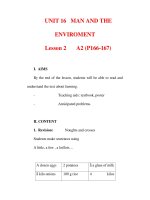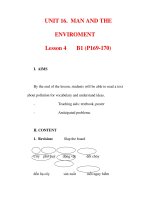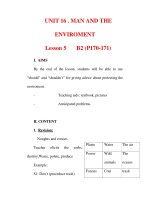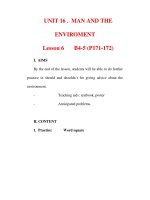Bài soạn môn học Tiếng Anh khối lớp 11 - Unit 16: Man and the environment - Section A, B
Bạn đang xem bản rút gọn của tài liệu. Xem và tải ngay bản đầy đủ của tài liệu tại đây (92.85 KB, 8 trang )
<span class='text_page_counter'>(1)</span>-1-. UNIT 16:. MAN AND THE ENVIRONMENT SECTION A: ANIMAL AND PLANTS. I. AIMS Students can ask questions with “how much”, “how many” and how to use the indefinite quantifiers as some, a lot, a little, a few. They know more new words about animals and plants. Especially, they got more knowledge about rare animals and how to protect them, and the pollution of the environment. II. PRESENTATION OF STRUCTURES 1- Structures How many eggs do his chickens produce? How much rice does he produce? Indefinite quantifiers: some, a few, a little, a lot of. Why? – because …. 2- Vocabulary: Rice cow grow Fruit buffalo produce Egg dog plow Cart cat pull III. TEACHING AIDS Pictures, some real things and a cassette. Controlled practice Free practice Concept Checking IV.TEACHING STEPS: Teacher A.1. Use pictures and some real things as chili, pens, books water to identify the meanings and usage of the quantifiers: some, a few, a little, a lot of. Let students listen and repeat: some rice, a lot of rice, a little rice, some eggs, a lot of eggs, a few eggs. Then have them take note. Lop11.com. Students Look at what the teacher shows and notice the meanings as well as the usage of the quantifiers some, a few, a little, a lot of. Listen and repeat Notes Countable uncountable nouns nouns some eggs some rice a lot of egg a lot of rice a few eggs a little rice.
<span class='text_page_counter'>(2)</span> -2A.2. Tell students about Mr. and his farm and write on the board the important details you want to emphasize: - some paddy fields - a lot of rice - a few vegetables - a little fruit - a lot of eggs…. Listen to the teacher’s story and notice the details written on the board. Try to retell the story, using the details written on the board. Answer requested.. the. questions. as. Ask questions to check their comprehension.. Read the passage again and practice asking and answering Ask students to red the in pairs. passage again then practice in pairs asking and answering Copy the passage in the questions. notebooks, write the questions and answers. Listen carefully to Let students copy the the teacher’s key answers and passage in their notebooks and correct if there are any write the questions and mistakes. answers. Give the key answers and retell the usage of “some, a lot of, a few, a little”. Ask them to correct their answers if there are any mistakes.. A.3. Explain the purpose of the Listen to the teacher and practice. Show them pictures notice the word “greens = green and introduce the new word vegetables”. “greens” = green vegetables Listen attentively. Try to Let them listen to the use the correct quantifiers as cassette and say the correct requested. quantifiers before the nouns indicating farm products. Do as the teacher requested. Say the quantifiers and the Call some students to retell words loudly. the right headings of each. Lop11.com.
<span class='text_page_counter'>(3)</span> -3-. A.4. items. Have them write the whole sentences in their notebooks key. a) a lot of d) a few b) some e) a little c) a lot of f) some. Notes 1) There 2) There 3) There 4) There 5) There 6) There. Mention the population of some cities or districts in Vietnam and the problems relating to the growth of popupalion.ask questions to attract their attention to the problems.. Listen to teachers careful. Try to answer the questions relating to the growth of the population.. - What more do we need when the population grow? - How can people get more meat/rice/ vegetables? -. How can get more land?. Ask students to read the passage carefully after listening.. are a lot of potatoes. are some tomatoes. are a lot of onions are a few vegetables. is a little rice. are some flowers.. Key answers: - The population growing… -. of…. is. More food / more land. - People have to produce more meat/rice/vegetables. -. They burn the forests.. Read the passage carefully. Answer the questions in full Have them answer the sentences, then copy the questions in full sentences then passage and the answers. copy in their notebooks-the passage and answers.. A.5. Retell the content of the Listen to the teacher, than above passage, ask some practice in pairs asking whquestions as models and ask question with “Why …?” and students to practice ask answer with “because…” questions with “why…?” and Look at the pictures and answer with “because…” notice the name of rare animals Use pictures to show in Asia which are in danger. students the rare animals which Write the questions and are in danger. Ask students to answers in the notebook repeat their names.. Lop11.com.
<span class='text_page_counter'>(4)</span> -4 Show leopard Indian python Bacteria camel elephant. - Because the population of world is growing.. Have them write the questions and answers in their notebooks.. - Because they need more fields.. Questions: 1) Why do we need more land? 2) Why do farmers burn the forest? 3) Why are these Animals in danger? Have them do exercises in the workbook from page 130 to 131.. Lop11.com. - Because people destroying their home environment.. are and. Do exercises as requested.
<span class='text_page_counter'>(5)</span> -5SECTION B: POLLUTION I. AIMS Students learn how to use new words about the pollution of the environment; use the present progressive tense to express the pollution of the environment which is happing at the moment. They also learn how to use the imperative mood, the modal verb “should – shouldn’t” to say or read some public rules or regulations about the protection of the environment. They get more knowledge on pollution and how to protect the environment. II. PRESENTATION OF STRUCTURES: 1- Structures Present progressive tense. We are destroying the forest What are we doing to protect our environment? What is polluting the air? Imperative. Do not damage trees Save water Should – shouldn’t We should put our trash in a bag We shouldn’t leave our trash. 2- Vocabulary Pollution destroy Environment burn Trash pollute Bottle keep off Can damage Save Collect III. TEACHING AIDS Pictures and a cassette IV.TEACHING STEPS: Teacher B.1. Students. Introduce the word Listen to the teacher and “environment” by writing it on look at the board notice the the board. spelling of “environment”. Ask them if they know any. Lop11.com. Tell the teacher the words.
<span class='text_page_counter'>(6)</span> -6words that relate the you know relating to the environment. Give them some environment as many as more new words such as “gases, possible. trash, coal, oil” Notice the meaning of the Tell them the meanings of new verbs “destroy, burn, the verbs destroy, burn, pollute. pollute”. Let them listen to the Listen to the cassette and cassette, then repeat sentence repeat the sentences chorally by sentence. then individually. Mention the pronunciation Pay attention to the of the new words. pronunciation of new words. Ask them to reread the Reread the passage passage carefully then practice carefully them practice asking asking and answering the and answering the questions. questions. Copy the passage, the Have them copy the questions and answer in the passage, the questions and notebook. correct answers in their - Because people are notebooks. destroying the forests. a) Why are wild animals - Gases are polluting the and plants in danger? air. b) What is polluting the air? - People are polluting the c) Where does the pollution air because they’re burning too come from? much coal, oil and gas. d) What land, the oceans?. is polluting rivers and. the the. - The pollution comes from gases and trash. - Trash is polluting land, rives and oceans.. B.2. the. Introduce the content of this Listen to the teacher’s new item and explain the introduction and explanation meanings of the phrase and notice the meanings. “following these rules”. Look at the board and read. Lop11.com.
<span class='text_page_counter'>(7)</span> -7 Write on the board what the rules by oneself. people should do and what they shouldn’t do. Listen to the cassette and read the rules as the teacher Let students listen to the requests. cassette and read these rules Write in the notebooks. aloud chorally and individually. Ask them to write in the notebooks DON’T () a) Don’t throw trash in the street. b) Don’t pick flowers. c) Don’t damage trees. d) Don’t throw trash in the country. . B.3. DO () e) Keep off the grass. f) Save. g) Collect paper. H) Collect bottles and cars. . Let students read over once, Read over once, listen to the give the meanings of the new teacher and notice the words. meanings of the new words. Have students listen to the Listen to the cassette and cassette then repeat sentences repeat chorally, then by sentence, then practice. individually. Have them memorizes it.. B.4. copy. and. Review the previous lesson by asking students what they should or shouldn’t do. Have students do some sentence transformation, use “should” or “shouldn’t” to rewrite the imperative sentences. Let them write in the notebooks. Let them listen to the cassette and repeat.. Copy and memorize. Listen to the teacher a try to answer the questions. Do the sentence transformation as the teacher requests, then rewrite in the notebooks. Listen to the cassette and repeat. Practice in pairs.. Have them practice in pairs. Lop11.com.
<span class='text_page_counter'>(8)</span> -8B.5. Show them pictures and ask Look at the pictures and try them questions to elicit the to answer the questions. meanings of the pictures. Practice in pairs. Make a Let them practice in pairs, similar dialogue with these use pictures to make a dialogue above, using “should or telling what they should or shouldn’t” shouldn’t do. Some pairs of students Call some pairs of students practice the dialogue in class. to play the roles in front of the class.. B.6. Introduce the two key words: “collect and recycle”. Use some real things as empty cans, bottles, waste paper to show students and attract their attention. Let students listen cassette, then ask them reread the passage.. to to. Ask them questions and let them answer. Have them practice in pairs. Ask some students to answer before the class. Correct if there are any mistakes. Ask them to take notes and learn by heart. Have them do the exercises on page 132, 133 in the workbook.. Lop11.com. Listen to the teacher’s introduction. Look at things he/she shows. Pay attention to what the teacher says. Listen to the cassette the reread the passage. Try to answer the questions. Practice in pair. Answer the questions. Correct if necessary. Take notes. Notes Imperative mood Affirmative: V + O/C Negative: Don’t + V + O/C Save water Don’t waste water. Advice We should save water. We should not waste water..
<span class='text_page_counter'>(9)</span>







